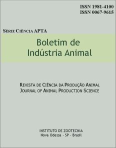Preliminary evaluation of several winter crops in a drained flat of the Paraiba Valley, State of São Paulo, Brazil
Abstract
The world was held during two years at the Estação Experimental de Zootecnia de Pindamonhangaba, located in the Paraíba Valley, State of São Paulo, Brazil. The soil of the site is an hydromorphic clay-sarndy one of a flat previously drained. The treatments were arranged is a randomized block design, with four replications. In the first year it was studied the following species: black oat (Avena strigosa Schreb), yellow oat (Avena byzantina Ckoch), abruzzi, gayerovo and white ryes (Secale cereale L.) PFT-766 and TCEP - 77138 triticales, ryegrass (Lolium multiflorum Lam.) Santa Maria and IAC - 9 soybeans (Glycine max L.), common veteh (Vicia salva L.) and white lupine (Lupinus albus L. ). In the second year it was studied: black oat, gayerovo and white ryes, ryegrass, Santa Maria soybean and white lupine. The evaluations were made by cuttings using a small mower, measuring the yield of dry matter per hectare, percentage of protein in the dry matter and the amount of protein per hectare. Is the first year ryegrass and the two oats yielded the most higher levels. In the second year, black oat showed highest forrage yield. However the evaluation of ryegrass had a restriction because its regrowth, after the first cut, as well as the one of black oat was consumed by cows that by chance grazed its plots. None of the legumes studied presented good behavior as forage plants because they had low forage yield and did not regrow after the first cut.Downloads
Downloads
Published
Issue
Section
License
Os autores não serão remunerados pela publicação de trabalhos, pois devem abrir mão de seus direitos autorais em favor deste periódico. Por outro lado, os autores ficam autorizados a publicar seus artigos, simultaneamente, em repositórios da instituição de sua origem, desde que citada a fonte da publicação original seja Boletim de Indústria Animal. A revista se reserva o direito de efetuar, nos originais, alterações de ordem normativa, ortográfica e gramatical, com vistas a manter o padrão culto da língua e a credibilidade do veículo. Respeitará, no entanto, o estilo de escrever dos autores. Alterações, correções ou sugestões de ordem conceitual serão encaminhadas aos autores, quando necessário. Nesses casos, os artigos, depois de adequados, deverão ser submetidos a nova apreciação. As opiniões emitidas pelos autores dos artigos são de sua exclusiva responsabilidade. Todo o conteúdo deste periódico, exceto onde está identificado, está licenciado sob a Licença Creative Commons Attribution (CC-BY-NC). A condição BY implica que os licenciados podem copiar, distribuir, exibir e executar a obra e fazer trabalhos derivados com base em que só se dão o autor ou licenciante os créditos na forma especificada por estes. A cláusula NC significa que os licenciados podem copiar, distribuir, exibir e executar a obra e fazer trabalhos derivados com base apenas para fins não comerciais.













